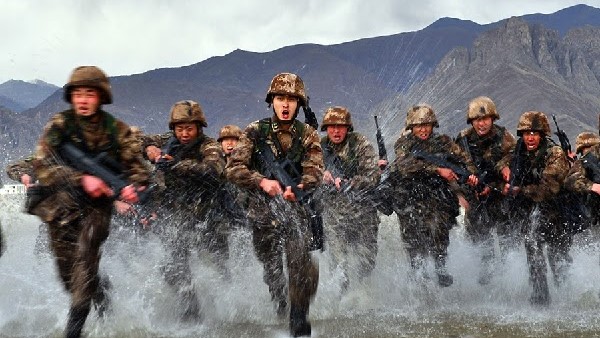Attempts by PLA to Recruit Ethnic Tibetans By Maj Gen AK Chaturvedi, AVSM, VSM (Retd)
![]()
Introduction
The PLA has been actively scouting for Hindi speaking Tibetans and Nepalis from Tibet Autonomous Region (TAR) to help both in interpretation and intelligence-gathering along the Line of Actual Control (LAC). The Tibet Military District, which comes under the People’s Liberation Army (PLA’s) Western Theatre Command and controls the lower half of the LAC, such as areas bordering India’s north-eastern states of Sikkim, Arunachal Pradesh, and Uttarakhand, has been carrying out recruitment drives in universities in TAR in search of Hindi graduates. Statistics suggest there are 7,000 active Tibetan military personnel in the PLA, of which around 1,000 Tibetans, including about 100 females, enrolled in Special Tibetan Army Units. As per the latest inputs, the massive recruitment drives conducted by the PLA’s Western Theatre Command are nearly complete.
Since June 2021, PLA has intensified the recruitment, training and deployment of special Tibetan units named Mimang Cheton along the LAC. PLA’s new Mimang Cheton units or Tibetan militia recruitment strategy has largely gone unnoticed in international media but the current dynamic along the LAC – involving ethnic communities – could be the making of a long-drawn conflict. Historically, PLA has used Tibetan militia to guide senior officials from the mainland and have worked in the logistics operations of the PLA. As per one report, it has been said that the PLA has launched a mandatory recruitment drive in the Chumbi Valley since August 2021. Approximately 1,200 Tibetan youth from Chumbi valley have been recruited and sent for training at the PLA training centre in Nagqu. The individual in charge of the recruitment drive is the PLA officer of Tibetan origin, Maj Gen Thubten Thinley. The militia recruitment drive has gained momentum since TAR ( Xi Jinping visited Lhasa and Nyingchi in July 2021.
The recruitment of young Tibetans into militia forces is happening in the Western regions of Tibet as well. Tibetan youth from Ngari prefecture have been recruited and sent for training at the PLA training centre in Kunming. As reported by some sources, the university graduates aged between 18 and 35 years recruited as officers will be offered 7000 yuan per month, and those who can speak and write Mandarin will be paid 5000 yuan per month.
PLA learning from India to Woo Tibetans
Now a new trend has been noticed. There has been a major push by the PLA for drafting Tibetans into the PLA since the start of 2021 after China was caught off guard by the performance of the Indian Special Frontier Force (SFF) comprising Tibetans-in-exile during Kailash Ridge operations in 2020.
Reports indicated that the Indian Army’s regular troops, along with the Tibetan of SFF of the Cabinet Secretariat, played a pivotal role in missions against the Chinese Army on the southern bank of Pangong Tso (lake) in Ladakh in 2020. They physically occupied the Mokhpari, Black Top, and other heights in response to Chinese aggression along the LAC. The Hindu reported earlier in 2021 that Mimang Cheton units have been trained and deployed in Chumbi Valley, including Yadong county.
India’s SFF
On late 31 August 2020, the SFF – a special operations unit primarily constituting exiled Tibetan soldiers – carried out a mission on the Southern bank of Pangong Tso Lake to deter China’s further ingress. In the operation, Tenzin Nyima, a Tibetan soldier of SFF, who was a part of the operation to capture Kailash heights, died in a mine blast. The Tibetans in SFF have been fighting for their land – Tibet. The incidents of Galwan and the Black Top Hill mission hide a more complicated history of a Tibetan nation, which still lives in the hearts and minds of people.
The SFF is an Indian special forces unit composed primarily of Tibetan refugees. It was established after the Sino-Indian War of 1962 with the primary objective of conducting covert operations behind Chinese lines in case of another conflict with China.
Initially, it was a small unit, but over time, it expanded in both size and scope of operations.
Author –  Maj Gen AK Chaturvedi, AVSM, VSM (Retd) is a retired Indian Army General Officer who has served in Jammu & Kashmir, NE, Andman Nikobar on various appointments at Command and Army HQs. . He is Sr Vice Chairman of Think Tank, “STRIVE”, after retirement is pursuing his favorite hobby of writing for newspapers, journals, and think tanks.
Maj Gen AK Chaturvedi, AVSM, VSM (Retd) is a retired Indian Army General Officer who has served in Jammu & Kashmir, NE, Andman Nikobar on various appointments at Command and Army HQs. . He is Sr Vice Chairman of Think Tank, “STRIVE”, after retirement is pursuing his favorite hobby of writing for newspapers, journals, and think tanks.
Disclaimer: The views expressed are those of the author and do not necessarily represent the views of the organisation that he belongs to or of the STRIVE.





